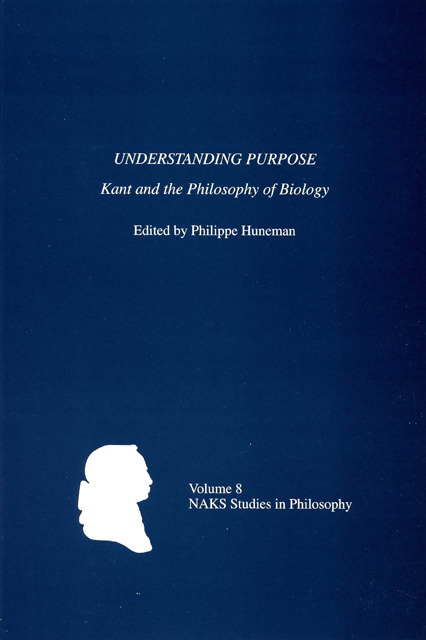Book contents
- Frontmatter
- Contents
- Acknowledgments
- Editor's Notes
- Introduction: Kant and Biology? A Quick Survey
- 1 Pre-Kantian Revival of Epigenesis: Caspar Friedrich Wolff's De formatione intestinorum (1768–69)
- 2 Kant's Persistent Ambivalence toward Epigenesis, 1764–90
- 3 Reflexive Judgment and Wolffian Embryology: Kant's Shift between the First and the Third Critiques
- 4 Kant's Explanatory Natural History: Generation and Classification of Organisms in Kant's Natural Philosophy
- 5 Succession of Functions and Classifications in Post-Kantian Naturphilosophie around 1800
- 6 Goethe's Use of Kant in the Erotics of Nature
- 7 Kant and British Bioscience
- Bibliography
- Contributors
- Index
5 - Succession of Functions and Classifications in Post-Kantian Naturphilosophie around 1800
Published online by Cambridge University Press: 10 March 2023
- Frontmatter
- Contents
- Acknowledgments
- Editor's Notes
- Introduction: Kant and Biology? A Quick Survey
- 1 Pre-Kantian Revival of Epigenesis: Caspar Friedrich Wolff's De formatione intestinorum (1768–69)
- 2 Kant's Persistent Ambivalence toward Epigenesis, 1764–90
- 3 Reflexive Judgment and Wolffian Embryology: Kant's Shift between the First and the Third Critiques
- 4 Kant's Explanatory Natural History: Generation and Classification of Organisms in Kant's Natural Philosophy
- 5 Succession of Functions and Classifications in Post-Kantian Naturphilosophie around 1800
- 6 Goethe's Use of Kant in the Erotics of Nature
- 7 Kant and British Bioscience
- Bibliography
- Contributors
- Index
Summary
Abstract
The concept of function plays an essential role in the classifi cations worked out by German naturalists at the turn of the eighteenth century. Kielmeyer (1793) talks of a gradation of five cardinal functions along the animal scale. Oken (1804) asserts a classifi cation of animals based on a progression of sensitive functions. Here, we intend to describe the relationships of those theses with the Kantian tradition, and to show how some Naturphilosophen, mostly Schelling's students, assume this “teleomechanist program” (Lenoir) in their interpretations of the diversity of beings.
Introduction
The notion of vital force played an extremely important role in the life sciences in the late eighteenth and the early nineteenth century, especially in the German world. This success reveals the deep changes undergone by these sciences at that time (failure of strict mechanism, development of vitalistic conceptions, etc.). It was closely associated with the notion of function, from which it was not always distinguished very clearly. Of course, these notions shared an eminently teleological component, and this aspect was frequently discussed by scientists and philosophers. In particular, Kant's position on the value of teleological principles in life sciences was supported, challenged, or transformed in different ways by German biologists such as Blumenbach, Kielmeyer, and Reil. Many historians, such as James Larson and Timothy Lenoir, have studied this diffi cult question.
Here we do not go into details of the philosophical implications of the development and the status of the refl ection on vital forces in the history of biology, but we would rather provide some elements on a particular topic, namely, the meeting point of these problems and another crucial issue that was central in biology at that time, that is, the classifi cation of living beings, particularly of the animals, and the use of physiological and anatomical arguments in the construction of the natural system. This is quite relevant to a study of what could be termed “Kantian biology,” since classifi cation is explicitly for Kant the focus of one kind of Naturlehre, exemplifi ed by Linnaeus’ natural history.
- Type
- Chapter
- Information
- Understanding PurposeKant and the Philosophy of Biology, pp. 123 - 136Publisher: Boydell & BrewerPrint publication year: 2007

